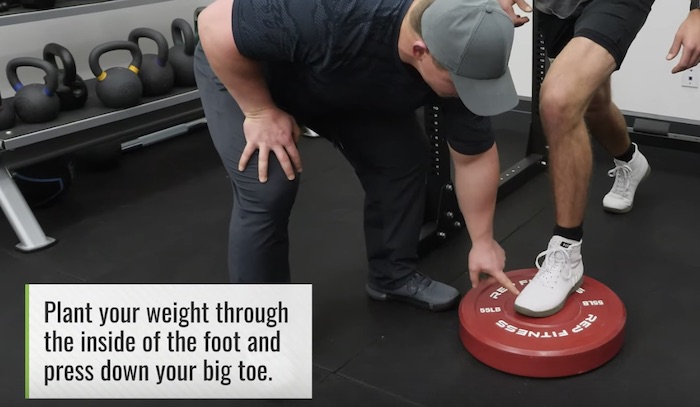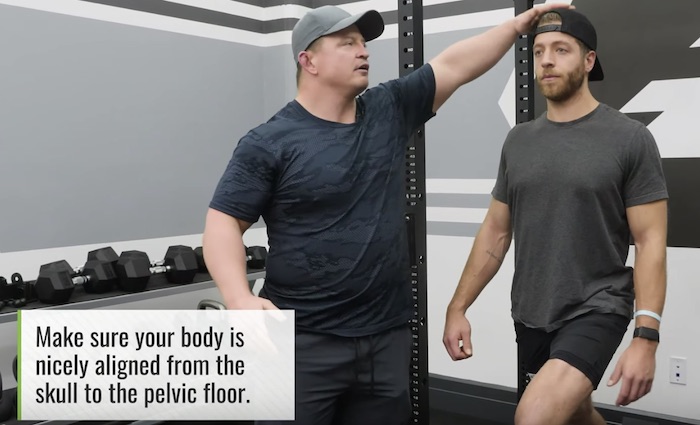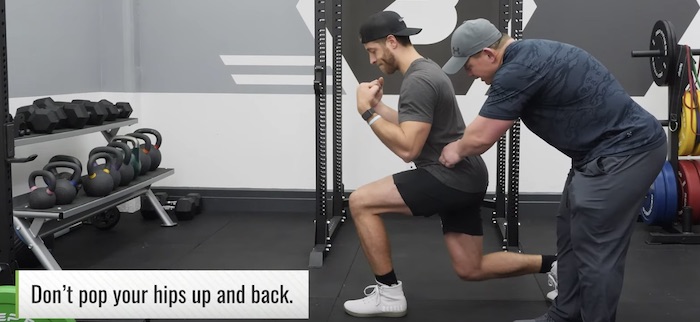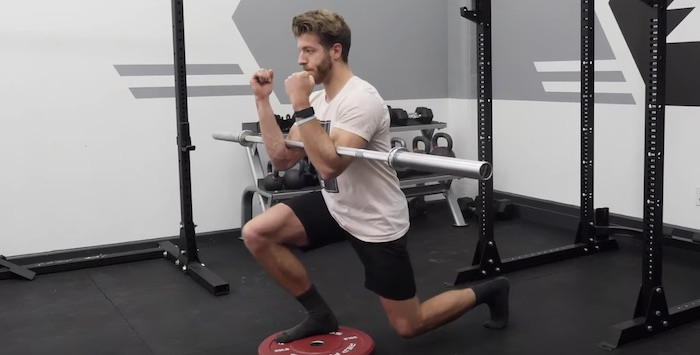The front foot elevated zercher split squat is an exercise that is not incredibly wide known and used yet, but we have a hunch that will soon change.
This exercise is absolutely fantastic for building lower body strength, and it’s incredibly useful for focusing on hypertrophy, unilateral skill acquisition, and resiliency of the core. Additionally, one of the best parts about this exercise is that every level fitness enthusiast can use them, as it is easily modifiable and scalable for different fitness levels.
In this article, we’re going to cover:
For the visual learners out there, check out the video below for detailed instruction on the front foot elevated zercher split squat from Dr. Pat Davidson.
How to Perform FFE Zercher Split Squats
The front foot elevated zercher split squat is a somewhat complex unilateral movement, so athletes should spend ample time practicing and learning the movement before trying to load them heavily. Follow the four steps below to perfect the ideal form.
1. Nail the Setup

To properly start this movement, it’s important to nail the setup. Place a 25, 45, or 55 lb plate on the ground, then assume a traditional split squat position. It’s important to place your emphasis on the inside of the foot, then grip the floor and press down into the big toe.
2. Align the Hips

Before beginning the first rep, it’s important to ensure the hips and body are properly aligned. Dr. Davidson points out that the hip of the opened leg should be stacked and aligned with the opposing hip to ensure proper movement mechanics are achieved.
If done properly, you should feel a natural tension in the adductors and glutes of the planted leg.
3. The Descent

Once you’ve achieved the proper alignment of the hips, now it’s time to start the descent. Dr. Davidson advises to have the knee track over the toe as far as possible, and to be weary of the alignment of the leg. Basically, have the knee track forward and avoid pushing the leg out laterally.
Similar to a split squat, you’ll lower yourself slowly controlling the eccentric loading. To ensure the torso remains in the correct position, make sure you’re keeping the elbows elevated slightly to engage the core, the torso should not be excessively flexed forward.
4. Elevator Not Escalator, the Ascent

When shifting from the eccentric to concentric position, Dr. Davidson’s wants you to think, “elevator, not escalator”. Basically, keep the hips from shooting backwards and focus on promoting the same posture and hip alignment throughout the entire movement.
Drive through the big toe and reach for a flat footed posture with the elbows remaining in the same position throughout.
Mistakes to Avoid
1. Shooting the Hips Back

The first mistake to avoid is shooting the hips backwards when shifting from the eccentric to concentric movement patterns. If this happens, then you’re losing tension in the legs and breaking form to most likely accommodate for load or you may be strengthening faulty movement patterns.
2. Dropping the Elbows
Another mistake worth keeping an eye on is dropping the elbows throughout the movement. The elbows should be elevated and remain in a similar position throughout. Ensure you’re raising the elbows and engaging the core and not simply reaching them outwards.
3. Moving the Knee Out Laterally
As stated in the how-to, the knee should track over the foot and not drift out laterally. If the knee is tracking out laterally, then you’ll be missing out on some of this movement’s adaptations.
Zercher Split Squat Benefits
1. The Hips Will Feel Incredible
Since this movement entails a large stretch on the hips and has a big emphasis on control and stability of the pelvis, then often times nagging aches and pain in the knees and thoracic can subside due to owning this position and building strength in this movement pattern.
2. Increased Range of Motion
With the front foot elevated, the hips will be forced to move through a range of motion that is otherwise unachievable when performing traditional split squats. By performing these consistently, the hips’ range of motion will increase naturally and stability will be a byproduct of this exercise’s execution.

3. Fitness Impacting Exercise
In addition to the two benefits above, Dr. Davidson puts this exercise in a rare category and states this movement can help you improve the following adaptations:
- Strength
- Hypertrophy
- Proprioception
- Cardiovascular Fitness
The summation of all of these can save both trainers and enthusiasts time when targeting a variety of adaptations.
Programming the Zercher Split Squat
Beginner | Use It to Learn
For beginners, use this exercise as a learning tool. Perform them unloaded or with a light load and focus on conquering the correct movement patterns.
Intermediate – Advanced | Use Them As An Accessory
For intermediate and advanced athletes who have performance goals, use this exercise as an accessory. Load them and perform them with an intensity and volume that coincides with your overall fitness goals. These variables will scale based on your fitness level, sport, and overall goals that you’re seeking to accomplish.
Wrapping Up
Dr. Davidson refers to this exercise as “finding gold” and that’s probably the best way to explain it. The front foot elevated zercher split squat can help you accomplish multiple adaptations at once, and deserves a spot in everyone’s training programs. Try them out, and let us know how you like them in the comments below!
FFE Zercher Split Squat FAQs
What muscles does the front foot elevated zercher split squat target?
The FFE zercher split squat targets multiple muscles groups including:
- Quads
- Glutes
- Hamstrings
- Core
- Upper Back
- Adductors
Can anyone perform front foot elevated zercher split squats?
Yes! This movement can be used by every fitness level and it should be scaled based on training age.
Beginners should use this exercise as a learning tool, and intermediate to advanced athletes can use this variation as a main accessory.
What are the benefits of the front foot elevated zercher split squat?
This exercise has a ton of benefits and these surround how many training adaptations come along with its execution.
For example, this exercise is great for targeting and training for:
- Skill Acquisition
- Mobility
- Strength
- Hypertrophy
- Proprioception
How should I progress the front foot elevated zercher split squat?
Some great ways to progress the difficulty of this movement include:
- Bodyweight
- Sandbag
- Light barbell
- Normal barbell with weight